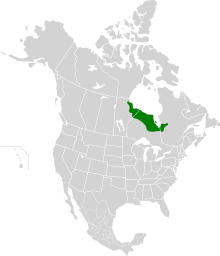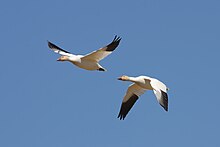The Hudson Bay Lowlands is a vast wetland located between the Canadian Shield and southern shores of Hudson Bay and James Bay. Most of the area lies within the province of Ontario, with smaller portions reaching into Manitoba and Quebec. Many wide and slow-moving rivers flow through this area toward the saltwater of Hudson Bay: these include the Churchill, Nelson and Hayes in Manitoba, Severn, Fawn, Winisk, Asheweig, Ekwan, Attawapiskat, and Albany in Ontario, and the Harricana, Rupert and Eastmain in Quebec.[1] This is the largest wetland in Canada, and one of the largest in the world.[2] The region can be subdivided into three bands running roughly northwest to southeast: the Coastal Hudson Bay Lowland (a narrow band along the northern coast),[3] Hudson Bay Lowland (a broader band extending to slightly south of the Ekwan River),[4] and James Bay Lowland (all the rest of the southern/eastern lands, making up close to 50% of the total Lowlands area).[5]
The entire area was covered by ice during the last glaciation, and the peatlands have accumulated over the last ten thousand years. Plants from more temperate regions mix with arctic species.[6] A majority of the wetland is peat bog, although salt marshes occur along the coast, and marshes and wet meadows occur along the major rivers. The wetlands provide important habitat for migratory birds including shorebirds (e.g., yellow rail) and waterfowl (e.g., snow geese). Large mammals include polar bears and wolverines.[2]


- ^ Canadian Encyclopedia - Hudson Bay
- ^ a b Abraham, K.F. and C.J. Keddy. The Hudson Bay Lowland. Pages 118–148 in L.H. Fraser and P.A. Keddy (eds.). 2005. The World's Largest Wetlands: Ecology and Conservation. Cambridge University Press, Cambridge, UK. 488 p.
- ^ Coastal Hudson Bay Lowland ecozone profile
- ^ Hudson Bay Lowland ecozone profile
- ^ James Bay Lowland ecozone profile
- ^ Riley, John L. 2003. Flora of the Hudson Bay Lowland and its Postglacial Origins. NRC Research Press, Ottawa, Canada. 236 p.